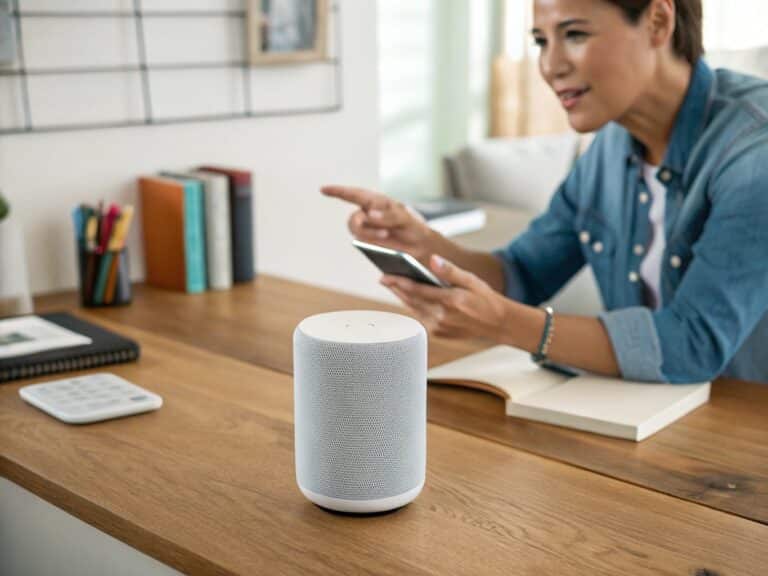The retail market is undergoing a strong transformation as voice-activated shopping is rapidly becoming a powerful force reshaping how consumers interact with brands and make purchases. Voice commerce represents a departure from traditional browsing and typing to conversational, hands-free transactions powered by sophisticated artificial intelligence. This evolution reflects changing consumer expectations for convenience, accessibility, and personalized experiences in an increasingly connected world.
Key Facts at a Glance
Market Growth & Size:
- Global voice commerce market valued at $42.75 billion in 2023, projected to reach $186.28 billion by 2030 (24.6% CAGR)
- Alternative projections estimate growth from $66.5 billion in 2024 to $714.5 billion by 2034 (26.8% CAGR)
- Voice shopping expected to account for 30% of e-commerce revenue by 2030
Device & Regional Leadership:
- Smart speakers dominate the market with 44-45.7% revenue share, led by Amazon Echo and Google Home
- North America holds 37.2% market share with approximately $24.7 billion in revenue (2024)
- Wearables segment experiencing fastest growth at 26.5% CAGR
Consumer Behavior & Adoption:
- Voice shoppers are 4.31% more likely to make purchases compared to social media shoppers
- 11.4% of consumers make impulsive purchases through voice assistants
- 71% of consumers prefer conducting queries via voice rather than typing
- 46% use voice search to check prices at local businesses; 41% use it to find grocery stores
Industry Applications:
- Consumer goods and retail sectors lead with 39-40.6% market share
- Retail & e-commerce expected to command 57.5% of voice commerce services market
- Banking, finance, travel, and healthcare sectors showing accelerated growth rates
Technology Foundation:
- Powered by artificial intelligence, natural language processing (NLP), and machine learning
- Voice authentication using biometric analysis for secure transactions
- Multiplatform integration across smartphones, smart speakers, wearables, smart TVs, and vehicles
Understanding Voice Commerce and Its Foundations
Voice commerce enables customers to search for products, place orders, and complete transactions using spoken commands through voice assistants like Amazon Alexa, Google Assistant, Apple Siri, and Microsoft Cortana. Unlike conventional online shopping that requires screens, keyboards, and multiple clicks, voice commerce allows users to interact with retail platforms through natural conversation.
The technology operates through a sophisticated integration of artificial intelligence and natural language processing. When a customer speaks a command, the voice assistant employs NLP to analyze and interpret the request, identifying keywords and understanding the user’s intent. The system then communicates with connected e-commerce platforms to retrieve product information and facilitate transactions.
Modern voice commerce systems utilize Natural Language Understanding to interpret not just the words but the context and intent behind customer requests. AI-powered algorithms process this information contextually, enabling assistants to comprehend nuanced queries and provide relevant responses. This technological foundation allows for increasingly sophisticated interactions that mirror human conversation rather than requiring rigid command structures.
The Explosive Growth of the Voice Commerce Market
The voice commerce sector has experienced remarkable expansion in recent years, with projections indicating continued rapid growth. The global market was valued at approximately 42.75 billion dollars in 2023 and is projected to reach 186.28 billion dollars by 2030, representing a compound annual growth rate of 24.6 percent. Other market analyses suggest even more aggressive growth trajectories, with forecasts ranging from 70.47 billion dollars in 2025 to 636.54 billion dollars by 2035.
North America currently dominates the market, accounting for more than 37 percent of global voice commerce revenue in 2024, driven by high adoption rates of smart speakers and voice assistants, particularly in the United States and Canada. However, emerging markets are demonstrating substantial growth potential as smartphone penetration increases and voice recognition technologies improve to accommodate diverse languages and accents.
By device category, smart speakers represent the largest segment, capturing over 44 percent of the market revenue in 2023. These devices, including Amazon Echo and Google Home, have achieved widespread consumer adoption due to their convenience and seamless integration into smart home ecosystems. The wearables segment is experiencing particularly rapid expansion, expected to grow at a rate of 26.5 percent during the forecast period, as fitness trackers and smartwatches increasingly incorporate voice commerce capabilities.
AI as the Catalyst for Voice Commerce Evolution
Artificial intelligence serves as the fundamental enabler that has transformed voice commerce from a novelty into a viable shopping channel. The intersection of AI, machine learning, and natural language processing has created intuitive, hands-free shopping experiences that mirror real-world interactions, allowing consumers to engage with devices using natural speech patterns.
Machine learning algorithms analyze user behavior, purchase history, and stated preferences to deliver personalized product recommendations. By examining previous interactions, virtual assistants can offer tailored suggestions that enhance user engagement and satisfaction, creating shopping experiences that become more refined over time.
Security represents a critical consideration in voice-based transactions. Voice authentication technology leverages AI-driven biometrics by analyzing unique vocal patterns, pitch, and speech dynamics to verify user identity. Unlike traditional passwords that can be compromised, voiceprints are nearly impossible to replicate, providing robust protection against fraud. Many systems implement multi-factor authentication, combining voice verification with additional security layers such as one-time passwords sent to registered devices.
Advanced systems can now analyze product specifications, compare competing brands using technical parameters, and provide objective assessments rather than relying solely on subjective reviews. Voice assistants can suggest alternatives based on personalized analysis of pricing, product attributes, and individual user preferences, transforming the comparative shopping phase.
The Smartphone Revolution and Voice Commerce Accessibility
The proliferation of smartphones has been instrumental in democratizing access to voice commerce capabilities. The increasing adoption of smart devices and the rise in smartphone penetration are primary drivers of voice assistant market growth. Voice assistants like Siri, Google Assistant, and Alexa on mobile phones offer users the convenience of hands-free interaction.
In rapidly developing markets like India, smartphone adoption is creating unprecedented opportunities for voice commerce expansion. The Indian smartphone market, already substantial, continues to grow significantly, providing a massive user base for voice-enabled shopping solutions. This mobile-first approach is particularly important in regions where desktop computer ownership is limited but smartphone usage is widespread.
Voice commerce reduces friction in the buying process by eliminating the need to attract customers to websites, navigate multiple landing pages, and manually enter payment information. With payment details stored securely in smart devices, customers can complete purchases without the cumbersome process of typing credit card numbers.
Consumer Benefits and Industry Applications
Voice commerce delivers substantial advantages across multiple dimensions of the shopping experience. Instead of endless scrolling and clicking, consumers can search for products hands-free using natural speech. Voice assistants learn user preferences over time, providing increasingly accurate recommendations tailored to individual tastes.
Voice shopping is projected to account for 30 percent of e-commerce revenue by 2030. Consumers who use voice shopping demonstrate higher purchase rates compared to those using social media shopping, being 4.31 percent more likely to buy through voice-enabled devices. Additionally, 11.4 percent of consumers admit to making impulsive purchases through voice assistants, highlighting the seamless nature of the transaction process.
The consumer goods segment currently holds the largest market share, accounting for over 39 percent of voice commerce revenue. Retail and e-commerce applications dominate, expected to command 57.5 percent of the market, as these sectors particularly benefit from routine tasks like reordering items, checking prices, and placing orders through simple voice commands.
Voice technology is making significant impacts in local commerce. Forty-six percent of consumers use voice search to investigate prices at local businesses, while 41 percent use it to locate grocery stores. This local search functionality creates opportunities for small and medium-sized businesses to reach customers through voice-optimized content.
The banking and financial services sectors are experiencing rapid voice commerce adoption. These sectors demonstrate particularly strong growth rates as voice-enabled ordering, search, and authentication cater to nearly half of applications requiring secure, fast commerce execution.
Future Prospects and Technological Advancement
The trajectory of voice commerce points toward increasingly sophisticated capabilities and broader integration across consumer touchpoints. The integration of voice commerce capabilities by e-commerce giants like Amazon, Walmart, and Alibaba has significantly expanded the market. These platforms enable users to reorder products, check delivery statuses, and make purchases hands-free, simplifying the shopping experience for broader audiences.
Multiplatform Integration
Voice commerce is expanding beyond isolated devices to create cohesive experiences across smartphones, tablets, smartwatches, smart televisions, and in-car infotainment systems. This multiplatform approach allows retailers to engage customers across different touchpoints throughout their daily routines, improving convenience, accessibility, and user engagement. By integrating voice capabilities with various platforms, businesses can enhance conversion rates, streamline the shopping journey, and create more personalized, frictionless experiences.
Enhanced Technological Capabilities
Predictive maintenance technology represents a promising advancement direction, leveraging data analytics to anticipate user needs and optimize voice commerce system performance. Advanced NLP algorithms analyze how users formulate queries, continuously refining the voice interface. Machine learning enables voice commerce systems to suggest products based on interaction history and anticipated needs.
The continuous improvement of voice recognition accuracy, particularly in noisy environments and with diverse accents, remains a priority. Enhanced natural language processing enables virtual assistants to better understand context, sentiment, and intent, facilitating more meaningful conversations. Integration of voice commerce with loyalty programs, subscription services, and personalized promotions creates additional value for both consumers and retailers.
Expansion into New Sectors
While retail and e-commerce currently dominate, sectors including banking, finance, travel, and healthcare are experiencing faster growth rates as voice technology matures. The market evolution shows voice-enabled ordering capturing the largest share initially, with voice-based search, discovery, and authentication functions gaining prominence as consumers become more comfortable with voice interactions.
Innovative applications like Estée Lauder’s voice-enabled makeup assistant demonstrate how voice technology can enhance accessibility. The system uses face scanning combined with voice commands to help visually impaired customers apply appropriate shades of cosmetics, exemplifying how voice commerce can improve business outcomes while advancing inclusivity.
Challenges and Strategic Considerations
Despite its promising trajectory, voice commerce faces several obstacles that must be addressed for widespread adoption. Privacy and security concerns remain paramount, as voice assistants continuously process sensitive personal and financial information. Businesses must implement robust data protection measures and transparent privacy policies to maintain consumer trust.
Regulatory compliance presents significant challenges for voice assistant developers. Adherence to global standards such as EU data privacy regulations, consumer protection laws, and localization requirements adds complexity, increasing development timelines and costs. These requirements create barriers to entry, particularly affecting smaller players and startups with limited resources.
Voice recognition accuracy, while improving, still encounters difficulties with heavy accents, background noise, and complex product names or technical specifications. Limited product selection in voice commerce platforms compared to traditional online shopping can hinder adoption, particularly for specialized or niche products requiring detailed visual examination.
The digital divide presents another challenge, as voice commerce adoption requires both internet connectivity and appropriate devices. Ensuring accessibility across diverse demographic groups, including elderly populations and those with varying levels of technical literacy, requires thoughtful design and implementation.
Strategic Opportunities for Businesses
For businesses seeking to capitalize on voice commerce growth, several strategic approaches can maximize success. Optimizing for voice search by linking products to relevant long-tail, conversational keywords that people naturally use when speaking to voice assistants is essential. Creating voice-friendly content that incorporates colloquialisms and phrases common to spoken language helps voice assistants understand and recommend products effectively.
Offering streamlined voice-activated shopping experiences with minimal steps between product discovery and purchase completion reduces friction and improves conversion rates. Providing customer support through voice assistants and voice-enabled chatbots enhances the overall customer experience while reducing support costs.
Businesses that invest in vernacular language support can dramatically expand their addressable market, particularly in linguistically diverse regions. Understanding local preferences, cultural nuances, and shopping behaviors enables more effective voice commerce implementations tailored to specific markets.
The development of comprehensive voice commerce strategies requires cross-functional collaboration involving technology teams, marketing departments, customer service operations, and senior leadership. Companies that treat voice commerce as an integrated channel rather than an isolated experiment are better positioned to realize its full potential.
Conclusion: The Voice Commerce Transformation
Voice commerce represents a fundamental evolution in how consumers discover, evaluate, and purchase products. The convergence of artificial intelligence, natural language processing, smartphone proliferation, and changing consumer expectations has created a powerful momentum driving voice commerce adoption. Consumers increasingly expect instant, accurate, and personalized responses, and AI enables brands to meet these demands at scale.
The market data demonstrates that voice commerce has moved beyond experimental phases into mainstream adoption, with substantial revenue generation and robust growth projections across multiple regions and sectors. While challenges related to accuracy, privacy, accessibility, and product selection remain, ongoing technological improvements and strategic business initiatives are systematically addressing these obstacles.
For developing markets specifically, the combination of high smartphone penetration, rising disposable income, localized language support, digital payment infrastructure, and government backing creates exceptional conditions for voice commerce expansion. The technology offers particular promise for reaching untapped consumer segments in non-metro regions, potentially democratizing access to e-commerce for hundreds of millions of people who previously faced barriers related to language, literacy, or interface complexity.
Businesses that recognize voice commerce as a strategic priority and invest appropriately in technology, content optimization, and customer experience design will be positioned to capture significant opportunities as this channel matures. The companies that embrace innovation, address accessibility challenges, and build trust through transparent privacy practices will lead the next phase of retail evolution.
As voice technology continues advancing and consumer comfort with voice interactions deepens, voice commerce will likely transition from an alternative shopping method to an integral component of omnichannel retail strategies. The future of commerce is increasingly conversational, personalized, and frictionless—characteristics that voice technology uniquely delivers at scale.
If you are interested in this topic, we suggest you check our articles:
- The Rise of AI-Generated Voices: Transforming Everyday Interactions
- OpenAI Strives for the Most Human-Like Voice
- The Future of Video Content Creation: Auto-Voice Narrated Visual Storytelling
Sources: Grand View Research, Verified Market Reports, The Business Research Company, Huawei, ResearchGate, market.us, Hypotenuse.ai, Future Market Instights
Written by Alius Noreika



